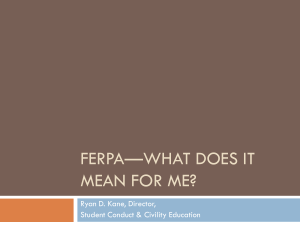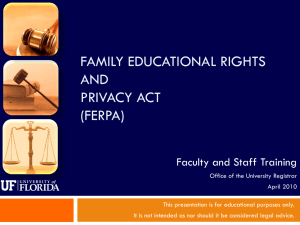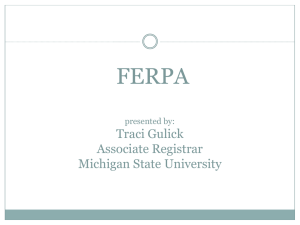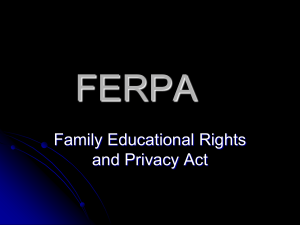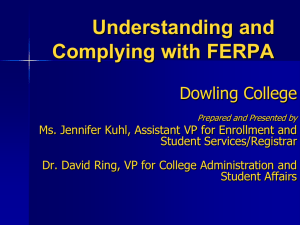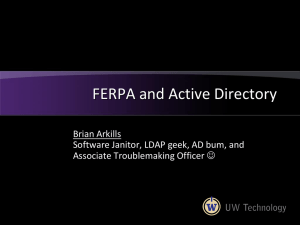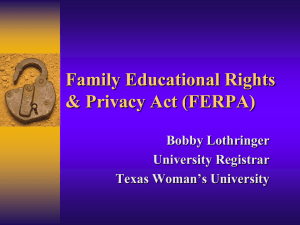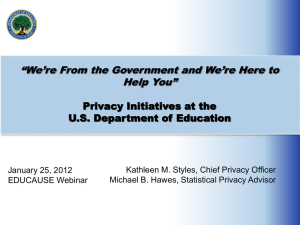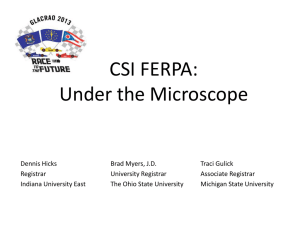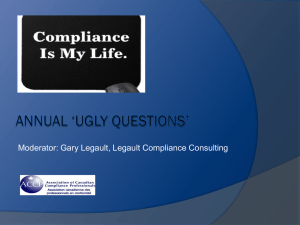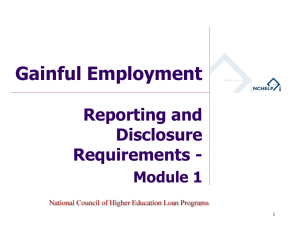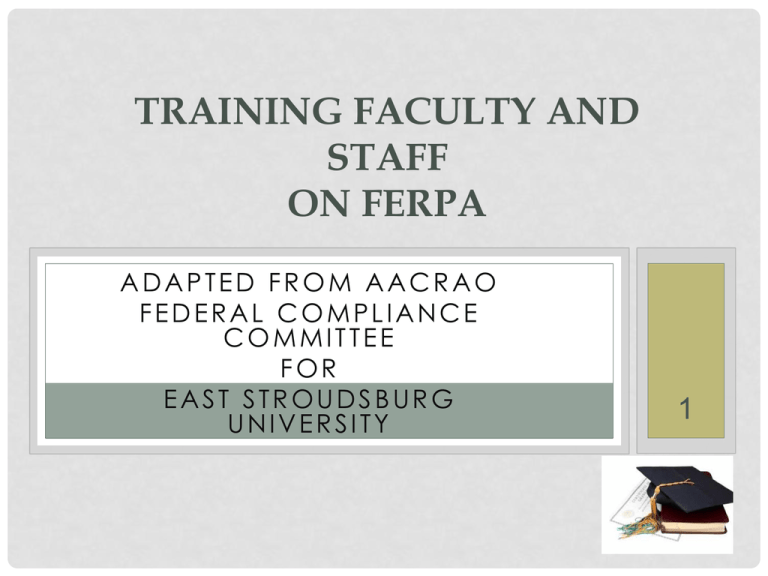
TRAINING FACULTY AND
STAFF
ON FERPA
ADAPTED FROM AACRAO
FEDERAL COMPLIANCE
COMMITTEE
FOR
EAST STROUDSBURG
UNIVERSITY
1
FAMILY EDUCATIONAL RIGHTS
AND PRIVACY ACT OF 1974
“A Federal Law designed to protect
the privacy of education records, to
establish the right of students to inspect
and review their education records,
and to provide guidelines for the
correction of inaccurate and
misleading data through informal and
formal hearings.”
2
FAMILY EDUCATIONAL RIGHTS
AND PRIVACY ACT OF 1974
This Act is enforced by the
Family Policy Compliance Office,
U.S. Department of Education,
Washington, D.C.
3
KEY TERMS
•
•
•
•
Education Record
Personally Identifiable
Directory Information
School Official
4
KEY CONCEPTS
• Required annual notification
• Written permission required for
disclosure of student education
record
• The exceptions to written permission
of student
• Students’ right to access their records
• The “musts” and “mays” in FERPA
• Parents/parental disclosure
• Legitimate Educational Interest
5
THE ESSENCE OF THE ACT
• College students must be permitted
to inspect their own education
records.
• School officials may not disclose
personally identifiable information
about students nor permit inspection
of their records without written
permission unless such action is
covered by certain exceptions
permitted by the Act.
6
WHAT IS AN “EDUCATION RECORD?”
• Any record, with certain exceptions,
maintained by an institution that is
directly related to a student or students.
This record can contain a student’s
name(s) or information from which an
individual student can be personally
(individually) identified.
• These records include: files, documents,
student papers and materials in whatever
medium (handwriting, print, tapes, disks,
film, microfilm, microfiche) which contain
information directly related to students
and from which students can be
personally (individually) identified.
7
“PERSONALLY IDENTIFIABLE”
Personally Identifiable means data or
information which includes:
1. The name of the student, the
student’s parent, or other family
members;
2. The student’s campus or home
address;
3. A personal identifier (such as a
social security number or student
number);
4. A list of personal characteristics or
other information which would
make the student’s identity known
with “reasonable certainty.”
8
GRADES POSTED ON BULLETIN
BOARD OUTSIDE OF INSTRUCTOR’S
OFFICE
FERPA
VIOLATION!!
9
GRADES POSTED ON BULLETIN
BOARD OUTSIDE OF INSTRUCTOR’S
OFFICE
• According to the Family Policy Compliance Office, it
is no longer acceptable to publicly post students
grades (or binders/portfolios/outcomes of student
work) using any portion of a student’s SSN or
student ID
• If an instructor wants to post grades in any public
way, he or she should use some code which is
known only to the instructor and each individual
student. For example, each student could have a
random number assigned at the beginning of the
term. The alphabetical order of the list must be
rearranged so that students cannot be personally
identified.
10
WHAT IS NOT AN EDUCATION
RECORD?
• “Sole Possession” notes
• Law enforcement unit records
• Records maintained exclusively for
individuals in their capacity as
employees
• Records of individuals who are employed
as a result of their status as students (work
study) are education records.
• Medical & Treatment records
• Alumni records
11
“SOLE POSSESSION NOTES”
Are made by one person as an individual
observation or recollection, are kept in the
possession of the maker, and are only shared
with a temporary substitute.
• This term has always been narrowly defined.
• Notes taken in conjunction with any other
person are not sole possession notes
(advisor’s notes, interview notes).
• Sharing these notes with another person, or
placing them in an area where they can be
viewed by others makes them “education
records” and subject to FERPA.
• Emails can never be sole possession.
• Best advice: If you don’t want it reviewed,
don’t write it down.
12
“SOLE POSSESSION NOTES”
Story #1--At an institution in the midwest, the Affirmative Action
Officer (subsequently referred to as the AAO) was investigating
a complaint filed by a student with the State’s Department of
Human Rights. The student alleged that she had been sexually
harassed by a faculty member. In the investigation, the AAO
interviewed all students who may have observed the alleged
incident. The AAO interviewed each student individually and
privately, and while interviewing, wrote notes of each
student’s observation and recollection. The AAO did not ask
each student to review the notes for accuracy and did not
share the notes with anyone. The interview notes were
maintained in the AAO’s office in a locked cabinet. No other
person had access to the notes. The AAO did review the
notes when preparing a response to the State Department of
Human Resources, but did not disclose the notes themselves to
anyone. Several years later, the student who had made the
accusation of sexual harassment discovered that the notes
existed and asked to see them since, under FERPA she said; a
student has the right to examine education records. The AAO
was advised by legal counsel that the notes were “sole
possession” records, and thus were not education records and
not subject to review by the student. The student then filed a
complaint with the Family Policy Compliance Office, claiming
that her “right to access” under FERPA had been denied.
13
“SOLE POSSESSION NOTES”
Story #1—
Was her “right to access” improperly
denied? The Family Policy Compliance
Office determined that since the notes had
been “…prepared with the assistance or
participation of others, such as the students
interviewed…”, the notes are education
records and the student must be provided
access to these records under FERPA.
Therefore, the notes in question are not sole
possession notes. The notes were redacted
to protect the privacy of the students who
had been interviewed and the notes were
provided to the complainant (student).
14
WHAT IS AN EDUCATION RECORD ?
(SUMMARY)
If you have a record that is:
• Maintained by your institution
• Personally identifiable to a student (directly
related to a student and from which a
student can be identified)
• Not one of the excluded categories of
records…
…then, you have an education record
and
It is subject to FERPA
15
REQUIREMENTS FOR COMPLIANCE
What we must do…
• Provide annual notification to students of
their FERPA Rights
• Provide students access to their education
records
16
REQUIREMENTS FOR COMPLIANCE
•
Provide annual notification to students of
their right to:
1. Inspect and review their education
records
2. Request an amendment to their
education records
3. A hearing if the request for an
amendment is unsatisfactory
4. Request that the institution not disclose
directory information items about them
5. File a complaint with the U.S.
Department of Education
17
REQUIREMENTS FOR COMPLIANCE
•
Provide annual notification to students of
their right to know:
6. 1) that school officials within the
institution may obtain information from
education records without obtaining
prior written consent, 2) the criteria for
determining who will be considered
school officials and 3) what legitimate
educational interest will entitle school
officials to have access to in education
records
18
REQUIREMENTS FOR COMPLIANCE
•
Provide annual notification to students of
their right to:
7. Know which information the institution
has designated as public or directory
information.
19
REQUIREMENTS FOR COMPLIANCE
Directory Information
• The institution must notify students of what
information the institution has designated as
directory information.
• The Family Policy Compliance Office has
recommended that this notification be part
of the institution’s annual FERPA notification
to students.
20
REQUIREMENTS FOR COMPLIANCE
Directory Information
• Information not normally considered a
violation of a person’s privacy
• Students must be notified of the items of
directory information
• Students must be given the opportunity to
request that directory information not be
released using the FERPA Restriction form.
This right of non-disclosure applies to
directory information only.
21
WHAT DIRECTORY INFORMATION
INCLUDES AT ESU?
Directory Information includes the following student
information:
•
•
•
•
•
•
•
•
•
Student’s name
Addresses, including e-mail
Telephone number
Place of birth
Major; Fields of study
Participation in officially
recognized activities and sports
Height/weight of athletic team
members
Dates of attendance
Degrees and awards received
•
•
Most recent educational
institution attended
Photographs
22
WHAT DIRECTORY INFORMATION
NEVER INCLUDES AT ESU?
• Race
• Gender
• Social Security Number (or part of an
SSN)
• Grades
• GPA
• Country of citizenship
• Religion
• Date of Birth
• Student ID Number (or part of the ID#)
23
DIRECTORY INFORMATION
• It is important to remember that directory
information be defined as such.
• If a data element isn’t defined as
directory information by ESU it isn’t
directory information and can only be
released if the student’s written
permission is obtained or the release
meets the requirements under one of the
exceptions to student’s written permission
found in FERPA.
24
DIRECTORY INFORMATION
• Student ID Numbers (SIN’s)
• The 2009 regulations made it clear that SIN’s cannot be
directory information unless they are being used as
electronic personal identifiers (e.g. as a user name), and
• If used to access data systems, they must be used in
conjunction with a secondary authentication factor, such
as a secret password or PIN.
25
REQUIREMENTS FOR COMPLIANCE
•
Provide annual notification to students of
their right to know:
6. 1) that school officials within the
institution may obtain information from
education records without obtaining
prior written consent, 2) the criteria for
determining who will be considered
school officials and 3) what “legitimate
educational interests” will entitle school
officials to have access to education
records.
26
“SCHOOL OFFICIALS”
A school official can be a person:
1. Employed by the college in an administrative,
supervisory, academic, research, or support
staff position (including law enforcement and
health staff personnel),
2. Elected to the Council of Trustees,
3. Or a company employed by or under contract
to the college to perform a specific task, such
as, an agent, an attorney, an auditor, or an
outsourced service provider.
4. Serving as a student representative on an
official committee, such as a disciplinary or
grievance committee, or assisting another
school official in performing his or her tasks.
27
REQUIREMENTS FOR COMPLIANCE
•
Provide annual notification to students of
their right to know:
6. 1) that school officials within the
institution may obtain information from
education records without obtaining
prior written consent, 2) the criteria for
determining who will be considered
school officials and 3) what legitimate
educational interest will entitle school
officials to have access to education
records.
28
“LEGITIMATE EDUCATIONAL
INTEREST”
Story #2
“Dear Ms. Registrar:
I am writing concerning the release of information about my
educational record to my ex-husband, Robert, the Director of
Financial Aid at ABC University. I refer to the unofficial grade
transcript that I gave to you during our meeting last week. I was
separated from him in December, 2007 and divorced from him in
October, 2008. We are currently involved in a court decision
concerning custody of our two children. In his answers to
interrogatories filed with my attorney on February 11, 2009, my exhusband wrote that he would submit the “educational record” of me
as evidence at the trial. My attorney said that he didn’t know how
my ex-husband would be able to supply the court with a copy of my
transcript, since that information is protected. On March 3, his lawyer
gave my lawyer several documents he intended to use as exhibits in
court, including my grade transcript. The hearing date was March 4.
At the hearing, his attorney did not submit my transcript itself, but he
submitted a sheet showing a set of bar graphs representing my
academic progress at your University as opposed to his progress at
Yale and Harvard. This sheet had been prepared by his new wife, a
faculty member in the Statistics Department. In his testimony, my exhusband also referred to my grades since the divorce, and to the
fact that I had completed the required number of hours for an M.A.,
but had not yet completed my thesis. My ex-husband has obtained
my unofficial transcript to further his case against me as a custodial
parent. I am angry that he has gotten this personal information about
me, and has shared it with his lawyer, my lawyer, his wife, and
perhaps other people as well. I am proud of my academic record,
but it is my record to disclose…”
31
“LEGITIMATE EDUCATIONAL
INTEREST”
Story #2
We, of course, would agree that this is a
violation of a student’s FERPA rights. It is also
an example of a school official (the exhusband) obtaining an education record
without a legitimate educational interest. This
was a serious violation of FERPA that could
have had serious legal implications for the
university. The lesson to be learned is that
there needs to be a continuous attempt to
inform all school officials, new and old, on
their FERPA responsibilities. FERPA is an Act
that involves any employee who comes in
contact with education records at any
institution.
32
REQUIREMENTS FOR COMPLIANCE
• Provide annual notification to students
of their FERPA Rights
• Provide students’ access to their
education records
33
REQUIREMENTS FOR COMPLIANCE
•
Provide students with access to their
education records
They have the right to:
1) Inspect and review within 45 days of the
request to inspect.
34
REQUIREMENTS FOR COMPLIANCE
Provide students with access to their education records
•
Limitations to the right to inspect (That
is, student do not have the right to
review the following)
•
•
•
Parental financial information
Confidential letters and
recommendations to which the student
has waived his/her right of inspection
Education records containing
information about more than one
student
•
The institution must permit access to that
part of the record which pertains only to
the inquiring student
35
SPECIAL NOTE ON CONFIDENTIAL
LETTERS OF RECOMMENDATION
•
•
•
•
Some selective institutions request the applicant to indicate
whether they waive, or do not waive, their right to inspect a
confidential letter or recommendation prior to providing the form
to the person requested to write the letter.
Remember that the confidential letter of recommendation
becomes an “education record” if maintained by the institution
after the student has begun attending the institution. Therefore, if
the student has not waived his/her right to review the letter, or has
not been given the opportunity to waive his/her right, it is subject
to review by the student.
You may want to find out if the individuals writing the letters of
recommendations are assuming that these letters are confidential
when, in fact, these letters may legally be reviewed by the student
after the student is attending the institution.
Include a redisclosure notice with your letter of recommendation.
E,g,. Please note that the aforementioned student has
waived his/her rights to access/review this letter of
recommendation. As such, this information should not
become part of the student’s education record at your
institution.
36
REQUIREMENTS FOR COMPLIANCE
(FOR ESU EMPLOYEES)
• Complete FERPA Training annually (that is, prior to
accessing student records each fall semester).
• Certify that you understand FERPA and that you will
comply with the regulations and ESU’s policy.
• If you complete training online:
• this is achieved by you successfully reviewing the presentation and
completing the FERPA Quiz
• Signing the Personal Commitment form and sending it to Enrollment
Services.
• If you complete training face-to-face
• this is achieved by you attending an onsite training session and
participating in the case scenarios provided.
• Adding your name and department to the FERPA Training Sign-In
Sheet that is collected by the trainer and returned to Enrollment
Services.
37
PROCEDURES AND STRATEGIES FOR
COMPLIANCE
A.
Disclosure of educational record information
1. Institutions shall obtain written consent
from the student before disclosing any
personally identifiable information from
their education records (with the
exceptions as noted in sections 2 and 3
below). The written consent must:
a. Specify the records to be released, e.g.
information regarding a current judicial
case or all judicial records
b. State the purpose of the disclosure
c. Identify the party or parties to whom
disclosure may be made
d. Be signed and dated by the student.
38
PROCEDURES AND STRATEGIES FOR
COMPLIANCE AT ESU
ESU has a single consent form
FERPA Disclosure Form
1. Downloadable from FERPA website:
www.esu.edu/ferpa
2. Must sign, date and forward to the
Center of Enrollment Services students
record to tag and inform other school
officials as necessary.
39
PROCEDURES AND STRATEGIES FOR
COMPLIANCE
A.
Disclosure of educational record information
2. Institutions must disclose education
records without written consent of
students to the following:
a. Students who request to see information
from their own records
40
PROCEDURES AND STRATEGIES FOR
COMPLIANCE
A.
Disclosure of educational record information
3. Institutions may disclose education
records without written consent of
students to the following:
a. School Officials, as discussed earlier.
b. Authorized representatives of the
following for audit, evaluation, or
enforcement of federal and state
supported programs:
•
•
•
•
Comptroller General of the United States
Secretary, U.S. Department of Education
U.S. Attorney General (law enforcement
only)
State educational authorities
41
PROCEDURES AND STRATEGIES FOR
COMPLIANCE
A.
Disclosure of educational record information
3. Institutions may disclose education
records without written consent of
students to the following:
c. Personnel within the institution
determined by the institution to have a
legitimate educational interest
d. Officials of other institutions in which the
student seeks to enroll, on condition that
the issuing institution makes a
reasonable attempt to inform the
student of the disclosure
42
PROCEDURES AND STRATEGIES FOR
COMPLIANCE
A.
Disclosure of educational record information
3. Institutions may disclose education
records without written consent of
students to the following:
e. Persons or organizations providing to
the student financial aid, or determining
financial aid decisions
f. Organizations conducting studies to
develop validate, and administer
predictive tests, to administer student
aid programs, or to improve instruction
43
PROCEDURES AND STRATEGIES FOR
COMPLIANCE
A.
Disclosure of educational record information
3. Institutions may disclose education
records without written consent of
students to the following:
g. Accrediting organizations carrying out
their accrediting functions
h. Parents of a student who have
established that student’s status as a
dependent as defined by the IRS Code
44
PROCEDURES AND STRATEGIES FOR
COMPLIANCE
A.
Disclosure of educational record information
3. Institutions may disclose education
records without written consent of
students to the following:
i.
Persons in compliance with a judicial
order or a lawfully issued subpoena,
provided that the institution first make
a reasonable attempt to notify the
student. Exception: If the subpoena is
issued from a federal grand jury, or for
a law enforcement purpose, and
orders the institution not to notify the
student.
45
PROCEDURES AND STRATEGIES FOR
COMPLIANCE
A.
Disclosure of educational record information
3. Institutions may disclose education
records without written consent of
students to the following:
j.
A court if the student has initiated legal
action against the institution or the
institution has initiated legal action
against the student
46
PROCEDURES AND STRATEGIES FOR
COMPLIANCE
A.
Disclosure of educational record information
3. Institutions may disclose education
records without written consent of
students to the following:
k. Persons in an emergency, if it is
determined that there is a rational basis
to believe there is a significant threat to
a student or other persons
47
PROCEDURES AND STRATEGIES FOR
COMPLIANCE
A.
Disclosure of educational record information
3. Institutions may disclose education
records without written consent of
students to the following:
l. An alleged victim of any crime of
violence of the results of any institutional
disciplinary proceeding against the
alleged perpetrator of that crime with
respect to that crime
48
PROCEDURES AND STRATEGIES FOR
COMPLIANCE
A.
Disclosure of education record information
3. Institutions may disclose education
records without written consent of
students to the following:
m. The public regarding the final results of
an institutional disciplinary proceeding
so long as the student has been
determined to be the alleged
perpetrator of a crime of violence or
non-forcible sex offense
49
WHAT DO THE “FINAL RESULTS”
INCLUDE?
• Must include only: the name of the
student, violation committed, and any
sanction imposed by the institution
against the student.
• The institution may not disclose the name
of any other student, including a victim
or witness, without prior written consent
of the other student.
50
PROCEDURES AND STRATEGIES FOR
COMPLIANCE
A.
Disclosure of education record information
3. Institutions may disclose education
records without written consent of
students to the following:
n. Parents of a student under the age of
21 regarding a violation of any law, at
any level, or institutional policy or rule
governing the use of alcohol or a
controlled substance
Does not supersede any state law that
prohibits disclosure of this information.
51
PROCEDURES AND STRATEGIES FOR
COMPLIANCE
A.
Disclosure of educational record information
4. Institutions may disclose information
about students to their parents by any
of four procedures:
a. By obtaining the student’s written
consent
b. By having the parents establish the
student’s dependency as defined by
Internal Revenue Code
c. By exercising its disclosure option on
any students under age 21 regarding
a violation of an institutional rule or
federal, state, or local law regarding
the use of alcohol or controlled
substance as long as state law permits.
d. In a health or safety emergency.
52
WHAT ABOUT PARENTS?
• When a student reaches the age of 18
or begins attending a postsecondary
institution regardless of age, FERPA rights
transfer to the student.
• Parents may obtain directory information
at the discretion of the institution.
• Parents may obtain non-directory
information (grades, GPA, etc.) at the
discretion of the institution AND after it
has been determined that their child is
legally their dependent.
• Parents may also obtain non-directory
information by obtaining a signed
consent from their child.
53
PROCEDURES AND STRATEGIES FOR
COMPLIANCE
A.
Disclosure of educational record information
5. Institutions may release without written
consent those records identified as
public or directory information for
students who are currently enrolled with
the following conditions:
a. That the institution inform the students of
those categories designated as
directory information
b. That students be given the opportunity
to refuse disclosure of any or all
categories
c. That the students be given a reasonable
period of time in which to state such
refusals in writing
54
PROCEDURES AND STRATEGIES FOR
COMPLIANCE
A.
Disclosure of educational record information
6.
7.
8.
Institutions may release without written
consent those items identified as public or
directory information on any students not
currently enrolled
Institutions may release without written
consent information on any student found
by a campus disciplinary body to have
committed a crime of violence or nonviolent sexual offense. The information that
may be released is limited to the following:
name, violation committed, sanction
imposed by the institution.
Institutions are responsible for informing
parties to whom personally identifiable
information is released that recipients are
not permitted to disclose the information to
others without written consent of the
students.
55
PROCEDURES AND STRATEGIES FOR
COMPLIANCE
B.
Records of requests and disclosures
1. All institutions are required to maintain
records of requests and disclosures of
education records
a. These records will include the names
and addresses of the requestor and
his/her indicated interest in the records.
56
PROCEDURES AND STRATEGIES FOR
COMPLIANCE
B.
Records of requests and disclosures
2. Records of requests and disclosure do
not have to be kept for:
a. Requests from students for their own use
b. Disclosures in response to written
requests from students
c. Requests made by school officials
d. Those specified as directory information
57
PROCEDURES AND STRATEGIES FOR
COMPLIANCE
B.
Records of requests and disclosures
3. These records of requests and
disclosures are part of the student’s
education records and must be
retained as long as the education
records to which they refer are
maintained by the institution.
58
KEY TERMS REVISITED
•
•
•
•
Education Record
Personally Identifiable
Directory Information
School Official
59
KEY CONCEPTS REVISITED
• Required annual notification
• Written permission required for
disclosure of student education
record
• The exceptions to written permission
of student
• Students’ right to access their records
• The “musts” and “mays” in FERPA
• Parents/parental disclosure
• Legitimate Educational Interest
60
CRITERIA TO BE USED IN DETERMINING A
LEGITIMATE EDUCATIONAL INTEREST
WHEN WRITING RECOMMENDATIONS
• Was the faculty member asked by the
student to provide the recommendation?
• What does the faculty contract specify
regarding the duties of faculty members?
Does or did the faculty member teach the
student in any course?
• Does the faculty member otherwise have
personal knowledge of the student’s
abilities?
• Did the student waive his/her right to review
a copy of the recommendation letter?
61
BALANCE POINTS/CHALLENGES
• The public’s right to know vs.
individual privacy rights
• Providing service vs. protecting
access to information
• FERPA vs. state’s open records laws
63
FERPA INFORMATION SOURCES
Family Policy Compliance Office
U.S. Department of Education
400 Maryland Ave., SW
Washington, D.C. 20202-5920
202-260-3887 (phone)
202-260-9001 (fax)
ferpa@ed.gov
http://www2.ed.gov/policy/gen/guid/fpco/index.htm
l
Or
ferpa@aacrao.org
64
FERPA INFORMATION SOURCES @
ESU
University Registrar
East Stroudsburg University
Center for Enrollment Services
Zimbar-Liljenstein Hall
200 Prospect Street
East Stroudsburg, PA 18301
registrar@esu.edu
http://www.esu.edu/ferpa
65

